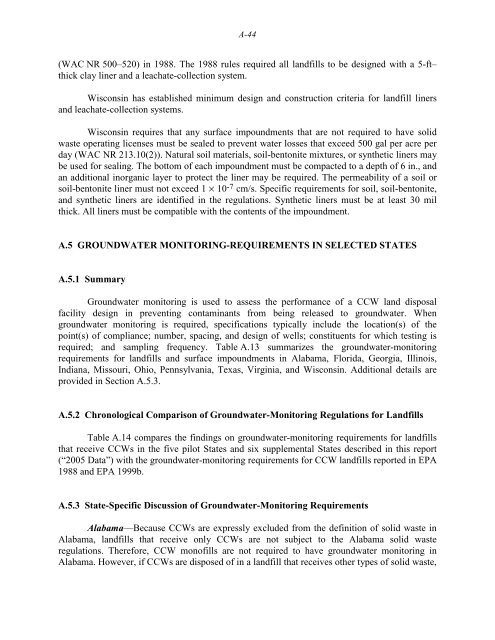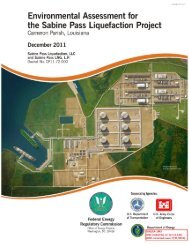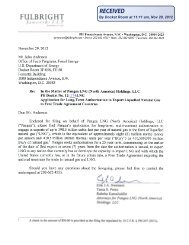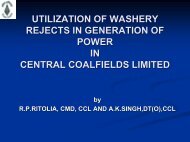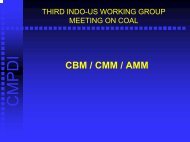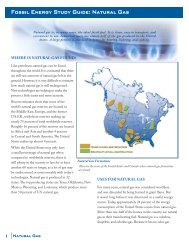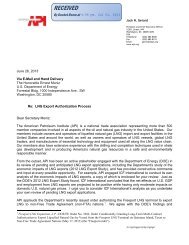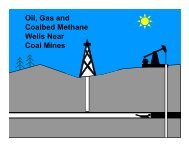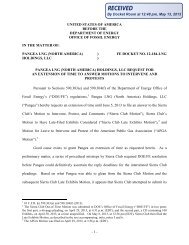Coal Combustion Waste Management at - DOE - Fossil Energy ...
Coal Combustion Waste Management at - DOE - Fossil Energy ...
Coal Combustion Waste Management at - DOE - Fossil Energy ...
Create successful ePaper yourself
Turn your PDF publications into a flip-book with our unique Google optimized e-Paper software.
A-44<br />
(WAC NR 500–520) in 1988. The 1988 rules required all landfills to be designed with a 5-ft–<br />
thick clay liner and a leach<strong>at</strong>e-collection system.<br />
Wisconsin has established minimum design and construction criteria for landfill liners<br />
and leach<strong>at</strong>e-collection systems.<br />
Wisconsin requires th<strong>at</strong> any surface impoundments th<strong>at</strong> are not required to have solid<br />
waste oper<strong>at</strong>ing licenses must be sealed to prevent w<strong>at</strong>er losses th<strong>at</strong> exceed 500 gal per acre per<br />
day (WAC NR 213.10(2)). N<strong>at</strong>ural soil m<strong>at</strong>erials, soil-bentonite mixtures, or synthetic liners may<br />
be used for sealing. The bottom of each impoundment must be compacted to a depth of 6 in., and<br />
an additional inorganic layer to protect the liner may be required. The permeability of a soil or<br />
soil-bentonite liner must not exceed 1 × 10 -7 cm/s. Specific requirements for soil, soil-bentonite,<br />
and synthetic liners are identified in the regul<strong>at</strong>ions. Synthetic liners must be <strong>at</strong> least 30 mil<br />
thick. All liners must be comp<strong>at</strong>ible with the contents of the impoundment.<br />
A.5 GROUNDWATER MONITORING-REQUIREMENTS IN SELECTED STATES<br />
A.5.1 Summary<br />
Groundw<strong>at</strong>er monitoring is used to assess the performance of a CCW land disposal<br />
facility design in preventing contaminants from being released to groundw<strong>at</strong>er. When<br />
groundw<strong>at</strong>er monitoring is required, specific<strong>at</strong>ions typically include the loc<strong>at</strong>ion(s) of the<br />
point(s) of compliance; number, spacing, and design of wells; constituents for which testing is<br />
required; and sampling frequency. Table A.13 summarizes the groundw<strong>at</strong>er-monitoring<br />
requirements for landfills and surface impoundments in Alabama, Florida, Georgia, Illinois,<br />
Indiana, Missouri, Ohio, Pennsylvania, Texas, Virginia, and Wisconsin. Additional details are<br />
provided in Section A.5.3.<br />
A.5.2 Chronological Comparison of Groundw<strong>at</strong>er-Monitoring Regul<strong>at</strong>ions for Landfills<br />
Table A.14 compares the findings on groundw<strong>at</strong>er-monitoring requirements for landfills<br />
th<strong>at</strong> receive CCWs in the five pilot St<strong>at</strong>es and six supplemental St<strong>at</strong>es described in this report<br />
(“2005 D<strong>at</strong>a”) with the groundw<strong>at</strong>er-monitoring requirements for CCW landfills reported in EPA<br />
1988 and EPA 1999b.<br />
A.5.3 St<strong>at</strong>e-Specific Discussion of Groundw<strong>at</strong>er-Monitoring Requirements<br />
Alabama—Because CCWs are expressly excluded from the definition of solid waste in<br />
Alabama, landfills th<strong>at</strong> receive only CCWs are not subject to the Alabama solid waste<br />
regul<strong>at</strong>ions. Therefore, CCW monofills are not required to have groundw<strong>at</strong>er monitoring in<br />
Alabama. However, if CCWs are disposed of in a landfill th<strong>at</strong> receives other types of solid waste,


